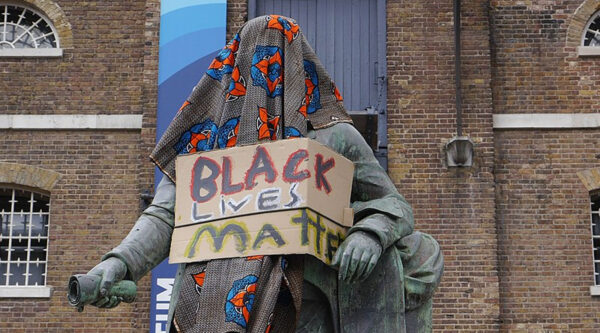A bronze sculpture of the merchant and slave trader Robert Milligan, that was removed from West India Quay in June 2020, will join the collections of the Museum of London.
Born in 1746, Robert Milligan was a prominent British slave trader and the driving force behind the foundation of West India Docks. As a slave trader and manager of his family’s Jamaican sugar plantations, Milligan’s wealth resulted directly from his trade in enslaved people. By the time of his death, he owned 2 sugar plantations and 526 slaves in Jamaica.
A statue of him had been based outside the Museum of London’s docklands outpost since it was moved there in 1997, but was removed from the plinth in June 2020 following a petition signed by over 4,000 people.
Having been removed, a consultation, which sought views on the future of the statue, its plinth and the area’s historical relationship to slavery, found that 76% of people were in favour of the statue being presented in an exhibition. 43% believed it should be moved into storage at the museum and 15% said it should be kept permanently out of public view.
Those in favour of keeping the statue on display suggested that it be shown with context about Milligan’s involvement in the creation of the docks, his links to the slave trade, and the recent Black Lives Matter movement.
The Museum of London Docklands, one of only three museums in the UK to address the history of the transatlantic slave trade, will now take possession of the statue as part of its collection. It will be held in storage whilst the museum consults further with local communities about how best to present it.
A Museum of London spokesperson, said: “The West India Docks, championed by Milligan using wealth from the slave trade, are a visible reminder of how this history has shaped our city. It is right and important that we acknowledge this in the statue’s story. We will now take time to consult with the local community to decide how best to take this forward as part of our collection.”
The West India Dock Company commissioned Richard Westmacott to create the statue of Milligan following his death in 1809. Originally unveiled in 1813, it commemorates his ‘genius, perseverance and guardian care.’ The statue was initially situated near the dock offices (1813-1875) before later being moved to the nearby Main Gate (1875-1943). It was placed in storage during the latter part of the Second World War and stayed there for over fifty years before being re-erected in February 1997 outside No.1 Warehouse.
The statue has been given to the Museum of London by the Canal & River Trust and becomes part of its permanent collection from March 2022. A decision has yet to be taken on the stone plinth outside the museum where the statue used to be based.









I think that many large cities will have a statue park. It could be called, “Contentious Park, London” perhaps. A place to take children to as part of their education maybe. Hiding bad history merely buries it and risks it happening over again. But by placing them all in an accessible place, they become a chapter in the history of the City that houses them. Plenty of room then for plaque’s with their deeds so that the visitor can make the decision for themselves.
As I recall, they did the same with the inscription on the Monument that blamed the Great Fire on “papist frenzy”. It was thought inappropriate after the Catholic Emancipation Act in the 1830s (quite apart from being total nonsense). But I think that’s in the Museum of London somewhere? Quite right too, it’s history and needs to be acknowledged; it doesn’t need to be a tourist attraction.